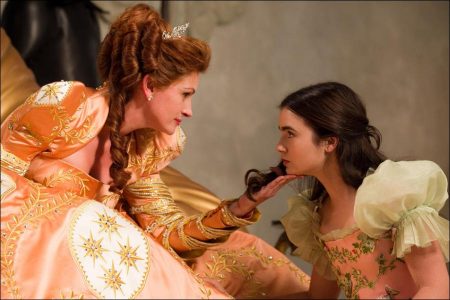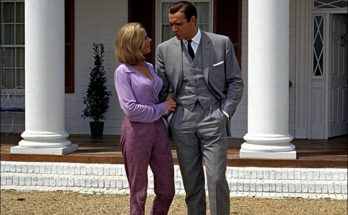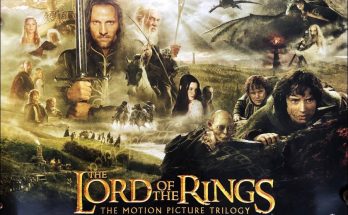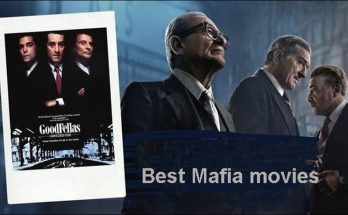Mirror Mirror: Building A Magical Realm. It will come as no surprise to anyone who has seen director Tarsem Singh’s earlier work that Mirror Mirror is an extraordinary visual feast. Built on massive sound stages in Montreal, the settings include a haunting snowbound forest, a rustic and richly detailed cabin inside a hollow tree, a gloriously over-the top Great Hall for the Queen’s elaborate and expensive fetes and a seemingly infinite palace bedroom in which to hatch her nefarious schemes. Complementing the fantastical locations are the film’s sumptuous costumes, hair and makeup, which leapfrog from century to century, incorporating both authentic historical detail and complete fantasy.
As executive producer Kevin Misher says, “Tarsem brings a blend of poetry, magic and visual flare to every film he works on. He incorporates a vast spectrum of influences from Eastern architecture to Western culture and everything in between.”
Production design was at the core of the film from the very beginning of the creative process, according to Singh. “When conceptualizing Mirror Mirror, I remembered a Russian film I’d seen called Ivan’s Childhood. There’s a romantic scene in that movie that takes place in a silver birch forest. I immediately thought that if I could have a similar set designed it could define the tone of this film.”
Singh explains his passion for visual detail this way, “Physically constructing an alternate reality is a beautiful experience. I want to create the world that the characters live in, so that the actors have a better understanding of how they should be portrayed. It was a real joy creating the world that these characters live in.”
Production designer Tom Foden, cinematographer Brendan Galvin and costume designer Eiko Ishioka have all collaborated with Singh on three earlier films. This longstanding artistic partnership was a keystone in the success of the production design, says Goldmann. “Tom and Tarsem have developed a way of working together to really define the look of the movie. Tom provided us with a great foundation for both the magic and the emotion we envisioned. He’s an incredible designer who helped us build characters with his work.
“Watching the sets take shape over time blew me away,” he continues. “I was always aware that I might never see a set like that again. It was really old fashioned moviemaking and it felt like we were making a Warner Bros.’ movie from the ’30s or ’40s. The level of detail and craftsmanship was unbelievable. It’s over-the-top opulent.”
Rather than depend on special effects to create the vast universe of Mirror Mirror, the filmmakers opted for practical sets whenever possible. “We certainly use green screen and wonderful visual effects in the film,” says Singh. “However, I also wanted to make the actors’ surroundings as visceral and real as possible. That’s why the sets had to be oversized.”
The production design was unlike any Roberts had seen before. “The sets are sensational,” she marvels. “The Magical Cottage, where the Queen meets with her alter ego, is beautiful and the Great Hall, where we did a lot of the party scenes, is mind-blowing. When you see the space filled up with all these people dressed in wild outfits, it’s really something. They don’t make many movies like this anymore.”
Hammer, too, says the sets were bigger and bolder than he could ever have imagined. “The Queen’s bedroom was bigger than most amphitheaters,” he says. “The whole atmosphere is so grand that you are able to suspend your disbelief. The scale is so enormous that it’s almost difficult to comprehend. People are going to walk into this film and see something truly unique.”
The equally sublime costumes, ranging from the Queen’s outrageous golden and blood red gowns to Snow White’s pastel court gowns and her spare and sculptural battle gear, were created by the late Eiko Ishioka in what was to be her last film. The Oscar-winning costume designer worked with Singh on four films before her death in January of 2012. “She was born outside the box,” says Singh of Ishioka. “Every director is always trying to get people to think differently. You never had to tell her that. Everything about her was unconventional, even her research and how she did it-and how much of it she did. She had two speeds: full speed and stop. When you have a person like that, you just never let them go.”
Ishioka, who earned an Oscar for the spectacular costumes in Francis Ford Coppola’s Dracula, was also a respected visual artist whose work is the permanent collection of the Museum of Modern Art in New York City. “She was an incredible artist,” says Singh. “She didn’t just design pieces of clothing, she created works of art.”
Her elaborate and imaginative designs combine pageantry and personality, drawing on influences from the 16th to 19th centuries to create something entirely new. “Eiko was all about spectacle,” says Goldmann. “But, like Tom Foden and Brendan Galvin, everything she did was also about building character. She was a genius at the visual, but she was also an amazing help in building Snow White’s and the Prince’s characters. The actors had an arc not only emotionally, but also physically.”
Impressively, her sensational designs were not limited to the gowns and suits worn by the film’s stars. Ishioka also designed the over 300 costumes that are worn by the film’s extras. Almost all were handmade. Hammer says that all that effort is part of what makes the film so special. “The costumes really set the tone for the entire movie. Eiko did a wonderful job creating something that seems so operatic and over the top, yet at the same time completely believable.”
Executive producer Kevin Misher says the collaboration between Singh and Ishioka went beyond the aesthetic to the spiritual. “The work they did together speaks to that connection,” he says. “I think her work on this film is a testament to her artistry in general and to their relationship in particular. It is a lovely gift she leaves for us to remember how special she was.”
Makeup and hairstyles designed for the film by hair and make-up artist Felicity Bowring add to the hyperbolic opulence of the costumes. “Everything stems from Eiko’s designs,” says Bowring. “It was delicious to work with her vibrant colors. Imagine people wearing vivid red, yellow, orange, green, hot pink and silver all in the same scene. For a costume ball, we created about ten face-painted animal masks for the guests instead of having the usual masks that go onto people’s faces. And the hair had to go with the proportions of the costumes. When a dress has a bustle that sits three feet out from the body, a wig has to offset that and be tall enough so that it too looks extraordinary.”
Mirror Mirror
Directed by: Tarsem Singh
Starring: Julia Roberts, Lily Collins, Armie Hammer, Nathan Lane, Robert Emms, Sean Bean, Mare Winningham, Jordan Prentice, Nadia Verrucci, Dawn Ford
Screenplay by: Melisa Wallack, Jason Keller
Production Design by: Tom Foden
Cinematography by: Brendan Galvin
Film Editing by: Robert Duffy, Nick Moore
Costume Design by: Eiko Ishioka
Set Decoration by: Jille Azis, Martine Giguère-Kazemirchuk, Daniel Hamelin, Alice Felton
Art Direction by: Nicolas Lepage, Jean-Pierre Paquet, Réal Proulx
Music by: Alan Menken
MPAA Rating: PG for some fantasy action and mild rude humor.
Studio: Relativity Media
Release Date: March 16, 2012
Related Link: View the Full Production Notes for Mirror Mirror
Visits: 39



